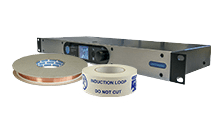For any hearing loop system one of the most important considerations is the audio input being provided to the loop amplifier. We have previously covered traditional “pro-audio” mic or line signals, but for some applications we also need to consider “line” connections at other signal levels, for example from low impedance speakers and 100 V line systems.
This document should help to outline the more common audio types we would come across and how to interface these signals with Ampetronic equipment.
100V line:
This one is pretty common even in the standard product sectors. PA and/or VA systems (public address and voice alarm) may be fairly common input sources. These will usually be found in large areas and concourses such as airports and rail stations, and an amplifier may be connected to multiple speakers connected across a potentially large area.
“Constant voltage” systems like 100 V (typically in Europe) and 70 V (typically US) traditionally use amplifiers stepped up to a high voltage with a transformer at the output, or a direct high voltage amplifier. The “constant” in the name states that at the rated maximum of the system, 100 V (or 70 V) RMS is nominally the maximum amplitude of the line signal regardless of the actual power delivered or load applied (of course, the voltage on the speaker line will change depending on the audio input level).
With high voltage on the line, less current is needed, so the wire gauge and wire length have a less limiting impact on the system. This allows large cable runs using thin gauge cable. In addition, many speakers can be connected, being limited (and easily calculated) by the total power of the 100V amplifier.
For example: a 200 W amplifier could run 4 x 50 W speakers in theory, but some headroom should be allowed.
Each speaker unit on the system usually requires a step-down transformer (often known as a “line transformer”) to step down the voltage for the actual speaker, and can be “tapped” from different transformer outputs to adjust the level locally.
100V inputs on Ampetronic loop drivers:
Some Ampetronic equipment will accept a 100V line input directly, with transformer isolation to avoid any problems caused by differing ground potentials.
-
-
- The C series has a direct 100V line input on the second input.
- The CLS1, CLS2, and CLS2-R1 offer a 100V line input.
- The T14-1 can accept a 100V input on either input
-
The impedance of a 100V line input on Ampetronic equipment is typically around 33 kOhm (about 0.3 W max load), so generally the induction loop amplifier can be considered to not apply any significant extra load to the speaker line.
Low Z (Low Impedance) Speakers:
Some Ampetronic products have an input which is suitable for use with low impedance speaker feeds such as those found inside intercoms and local audio on kiosks. The HLS-DM range (including the DM2, DM1, 2C, 2A and 1A variations) and T14-1 range (on the ‘3V’ input) are typical examples.
You can connect the HLS or T14-1 in parallel with the low impedance speaker straight to the input on the HLS amplifier. The impedance of the inputs is high enough (about 2 kOhm) that it will not noticeably affect the power available to drive the speaker they are connected to.
Adaptors:
Other Ampetronic equipment will require an adaptor when connecting a 100V line.
For most products, the ATT-UJ or ATT-UX can be used to attenuate either a 100V (or 70V / 30V) line or a low Z speaker signal to audio line or mic levels. The input characteristics are similar to the built-in inputs described above however they also have selectable output attenuation to ensure closer level matching across a variety of applications. The ATT-U products also include transformer isolation.
If using the HLS-2C active loop panel, the HLS-UA accessory provides both an AC mains power adapter and an ATT-U input adapter (as above) in a metal IP65 enclosure with easy to use spring-terminal connectors.
Other Input levels:
We have found inputs at other (less common) levels such as those from VoIP phone or computer audio outputs. If the input is too high in level, the ATT-UJ or ATT-UX have a variety of output levels which may be suitable. However, there may be instances where the level needs to be amplified to match a mic or line level input, or the output of an ATT-U product is then connected to a microphone input to provide enough gain as well as transformer isolation.
Regardless of the signal type it is important to make sure that the audio content is suitable. Sometimes this means providing a dedicated feed for the hearing loop if possible, for example to avoid equalisation intended for the acoustic space being applied to the assistive listening signal.
If you have any questions about connecting audio signals to your hearing loop system then our support team are on hand to help, contact us at support@ampetronic.com, +44 (0) 1636 610062 or live chat.

Rob Bartlam
Support Team Lead & Transport Specialist
Since joining Ampetronic in 2017, Rob has incorporated skills and knowledge from his BSc in Audio & Recording Technology into the world of audio induction loops. Starting as a system design engineer, interests have led him into a more specialised role within the OEM team, designing systems and supporting customers with more bespoke projects, mostly within the transport sector. Rob has also evolved to a team leader role within the wider support team, advising on a variety of projects in different markets and sectors, involving the full range of Ampetronic products.


